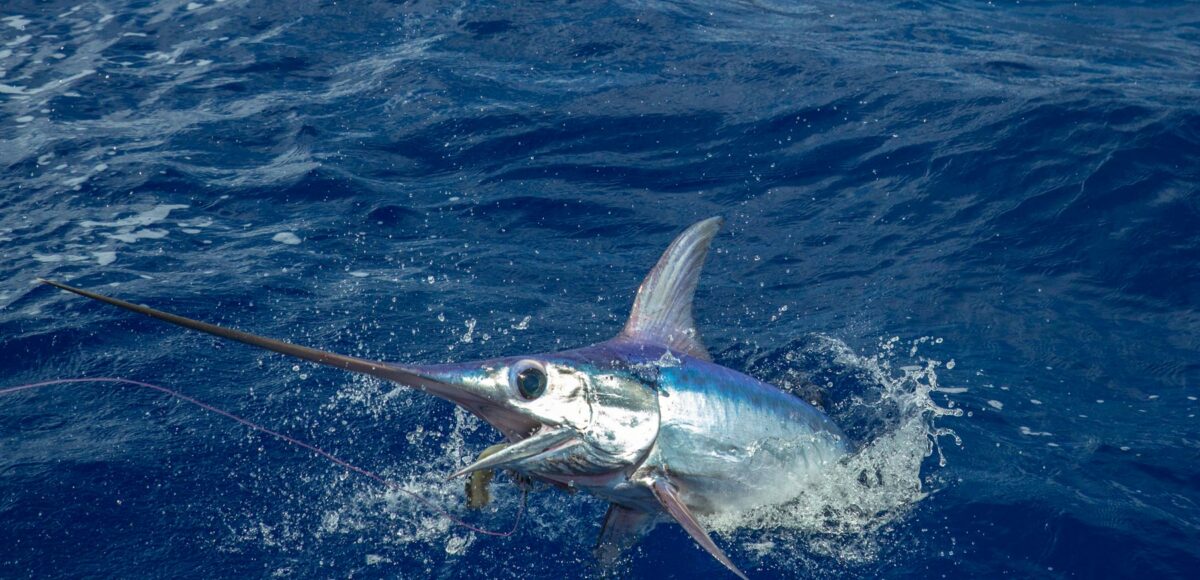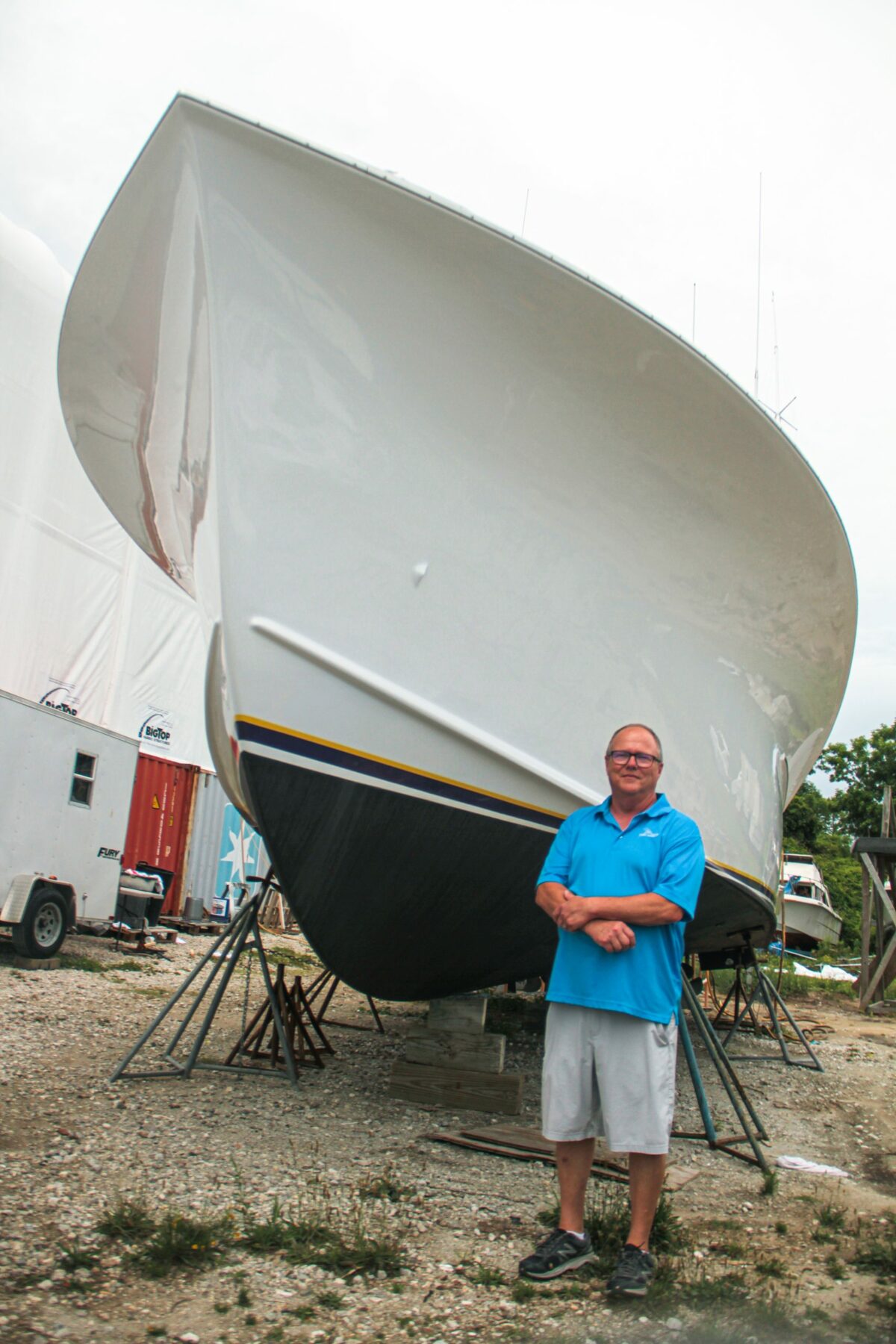Table of Contents
In August of 2022, Brandon Carney headed offshore out of Morehead City, North Carolina, on a revenge mission. It was his second attempt at swordfishing on his 32’ Contender, Willow-B. Carney’s first crack at the Carolina swords had ended with heartbreak, losing a fish just before the crew was able to get the harpoon into the broadbill boatside. Little did he and his crew know that they’d make up for the first lost fish in a big way. On the second drop of the day, Carney’s albacore belly strip was inhaled by a sword that not only avenged the previously lost fish but ended up setting the new North Carolina state record for the species. Brandon’s father, Cary, did the honors on the reel.
A timely tackle failure ended up being the difference maker in the catch qualifying for the record. A fuse blew on the electric reel as the sword began its initial run, forcing Cary to hand-crank the monster from the depths in a battle that lasted about 2 ½ hours and towed the crew some 12 miles. Carney tells me they had no idea exactly how big the fish was when it finally got alongside the Willow-B,but it later hit the scales at 504.4 pounds. This bested the long-standing North Carolina mark of 441 pounds set in 1979 by Horace Murray.
Swordfish swimming off the North Carolina coast isn’t a new thing, as guys like Murray were targeting the deep-water billfish years ago. But along with the rest of the East Coast, the mid-Atlantic has seen a resurgence in the species over the last decade. This is a result of longline bans that have made the daytime fishery famous in the waters off South Florida. While the North Carolina fishery doesn’t get the same amount of attention, and the grounds are not as easy to access as those off the Sunshine State, it seems like the fishing can be just as dependable. The guys I talked to reported very light fishing pressure for swords along the North Carolina coast, with consistent action and a year-round fishery. The daytime tactics are also like those in Florida, pioneered by the likes of Bouncer Smith, RJ Boyle and Nick Stanczyk, among others. The local North Carolina fishermen told me their setup was based on the same ideas, with each adding their own touch based on their preferences and conditions.
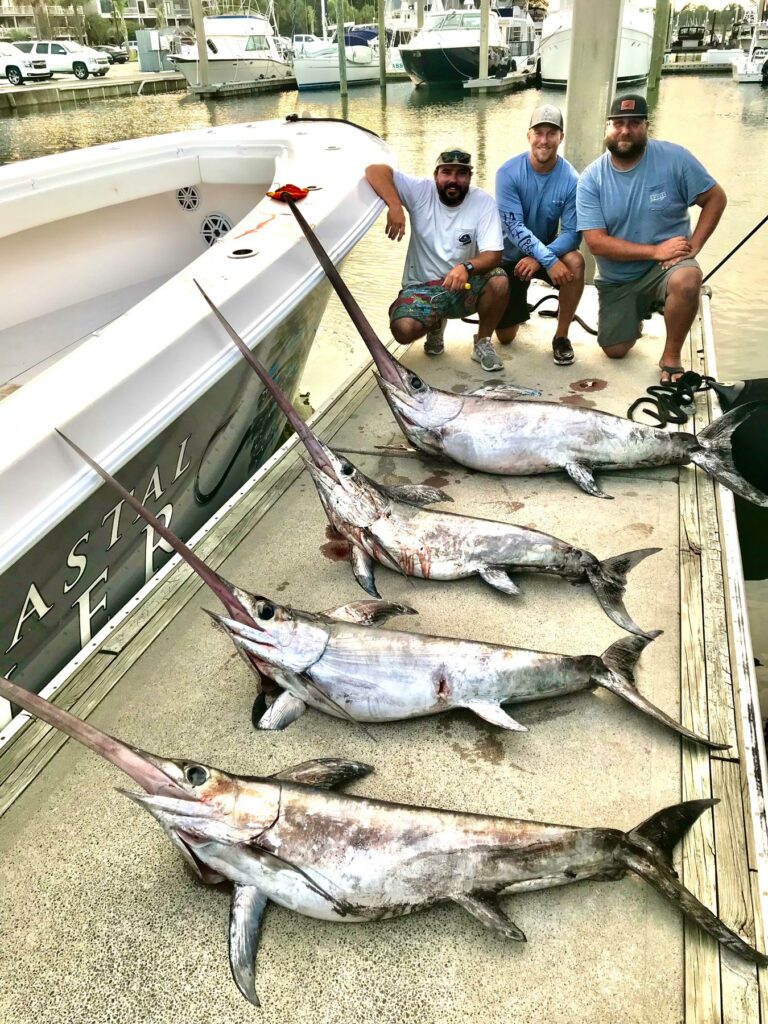
When and Where for NC Swords
Capt. Michael Tickle of the Waste Knot has been fishing for swords in his home waters off Morehead City for about eight years. He tells me that he’s now caught them every month of the year. His favorite time to go is following a new moon.
“If you look in the sky and it looks like the moon will hold water, you can usually look online up and down the coast and see that fish are being caught. Generally, if I’m going out and I see that little thumbnail up in the sky, it makes me pretty happy,” Tickle says.
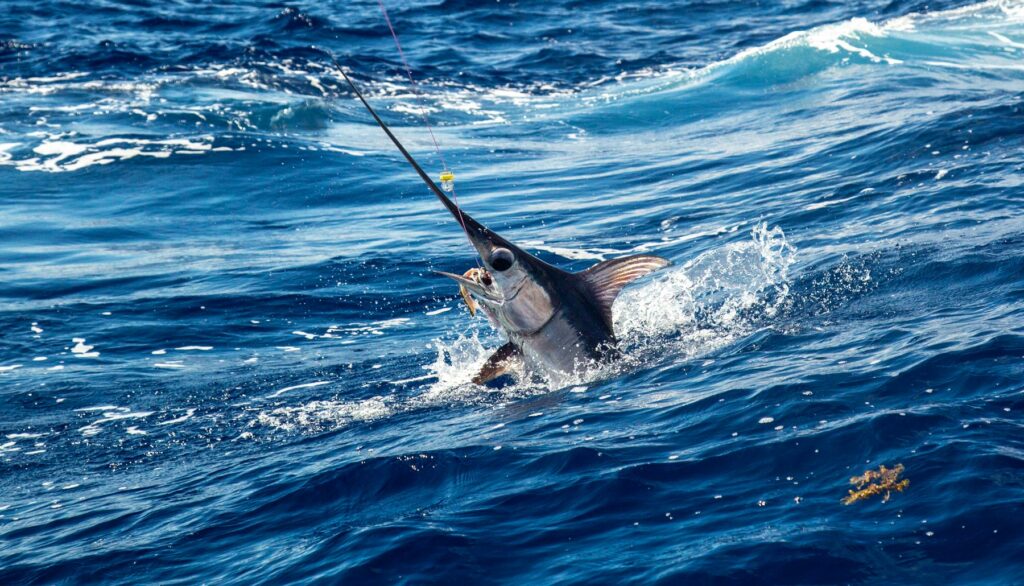
He likes to find bright blue Gulf Stream water, with current moving across the area he wants to fish. Everyone I spoke to said that if there’s no water moving, it’s generally not good for fishing and difficult to make a proper drift. Unlike the fishery off Florida where the sword grounds can be within fifteen miles, the run in North Carolina can be 60 to 80 miles, so you must pick your days accordingly. Because you’re essentially drifting with the current, the fishing can be exponentially tougher to do if you’re fighting rough seas. Tickle doesn’t think surface temperature makes much of a difference for swordfish, because there’s such a vast difference in the temperature of the deep, dark waters where the swords swim during the daytime. But don’t completely neglect the temperature charts. If there’s a good piece of water moving through an area, it could still be a good indication of life.
You’ll have to go deep to find a swordfish off North Carolina. The guys I spoke with liked the zone between 1400’ to 1600’. Swords have been caught much shallower and much deeper than this, but depths around 1500’ seem to be the sweet spot. Most fish are feeding from the bottom to about 250’ above it during the day. The common practice is to drop your bait to find the bottom and then crank up to about 100’ above it depending on the variance in the contour you’re working.
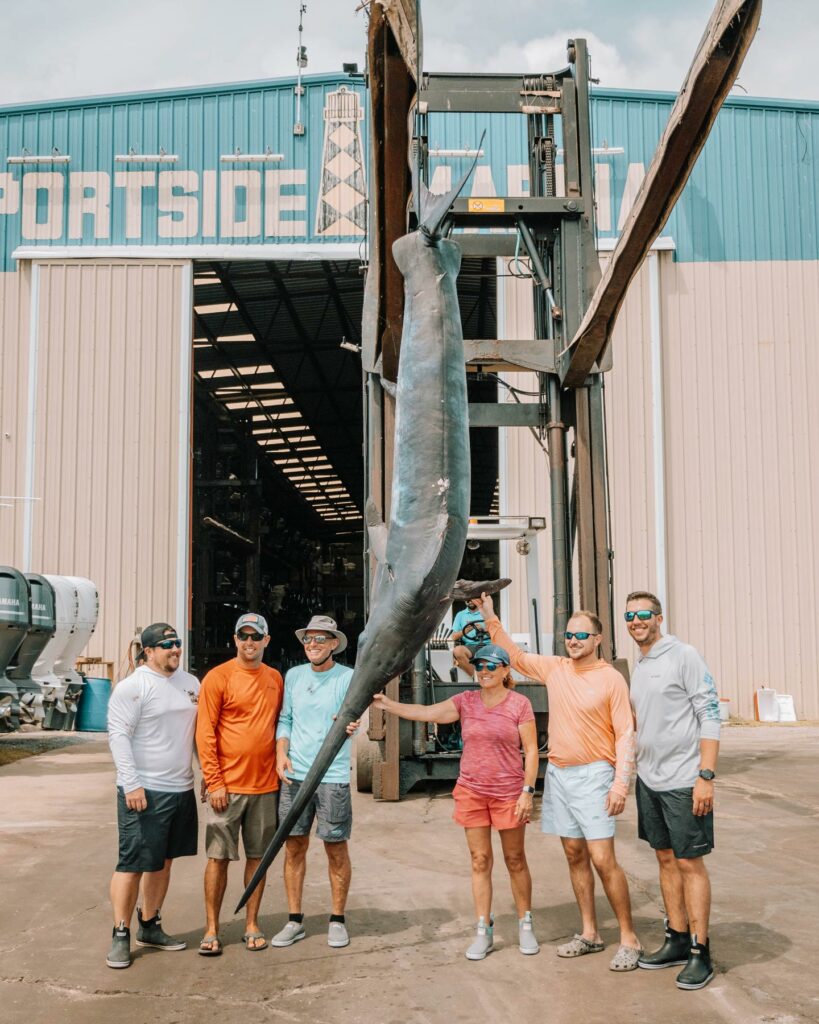
Capts. Jackson David and Ben Morris have worked to dial in the swordfishing off Wrightsville Beach for the last few years to achieve consistent action. Even though in the daytime, swords are extreme subsurface feeders, these captains say that you’re looking for an area with current, contour or structure, and clean blue water. Like other species, swords will hang in areas out of the current where they can wait for the tide to funnel bait into their zone. They like a mud bottom, which is evident in the way that your sinker makes a “thud” on the bottom. Swords like to use their bill to dig in the mud and feed on the shrimp and other creatures hiding in the mud. David notes that the bottom off Wrightsville Beach seems to be predominately harder than the muddier bottoms farther north off Morehead City.
Getting Geared Up With The Right Tackle
Swordfish are highly migratory and opportunistic feeders. They feed on a variety of fish, shrimp and squid, and because of the huge area they cover in the water column, virtually nothing is off-limits. This means your bait can vary, but the main thing you want is something that will still be attached and presentable after dropping 2000’ and won’t fall apart as soon as a sword starts hitting it. Tickle’s favorite sword bait is an albacore belly, but eels, bonito, wahoo or dolphin bellies are popular choices as well. The rigging is like a Panama strip bait for trolling. The belly strips are usually about 12” to 18” long, with the hook punched through the strip so the shank of the hook lays flat against the belly. Then the leader is run through the hook and through the top of the belly. The bait is then flossed and cross-stitched through the top of the strip to bind it to the hook. Squid skirts are usually stitched on the front of the bait to clean up the presentation. For hooks, tunastyle Js around a 10/0 is the standard, such as the Mustad 7732 and 7691.
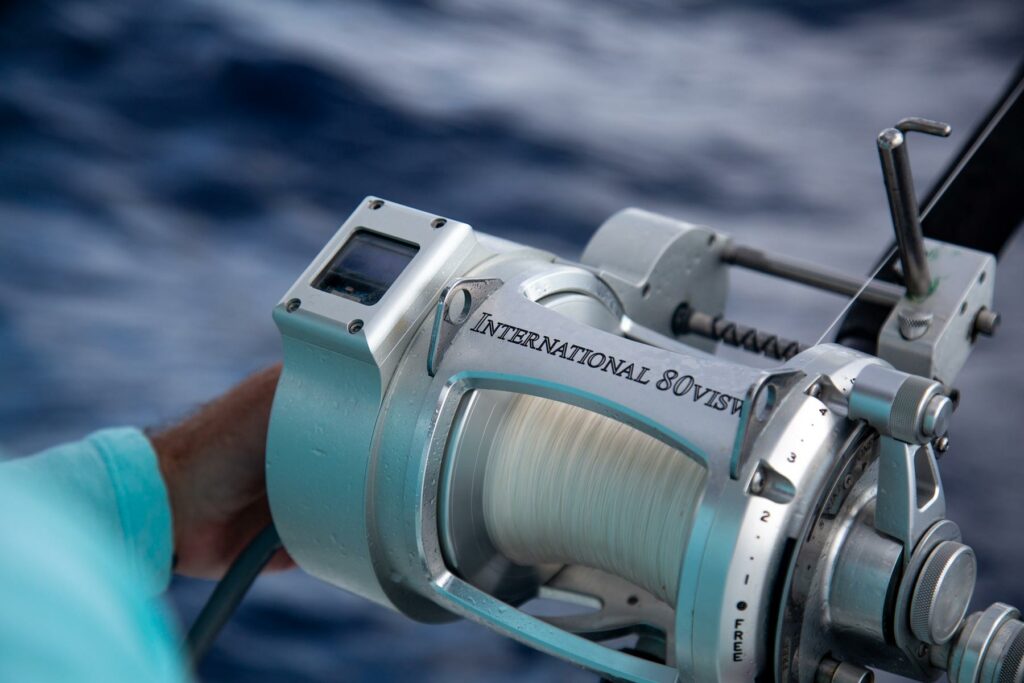
Electric reels are commonly used for the extreme depth required for swordfish, with Hooker and LP popular along with offerings by Daiwa and a few other companies. There are some hardcore hand-crankers out there as well, but many anglers choose to start hand-cranking just after the weight has been removed when fighting a fish. Once you check a bait a few times at that depth, you’ll see the draw in fishing electrics. Braid in sizes from 60 to 100 pounds is the standard for the main line. The braid cuts through the water well and the 80-pound size is a good mix of strength and lack of friction with the massive amount of line out. From there, it’s a 250-pound test wind-on leader that’s 100’ to 150’ long, swivel, and a 250-to-300-pound bite leader to the hook. A floss connection is used about four to five feet from the braid to wind-on where the weight is attached by a longline clip. Two or three lights are attached by rubber bands on the wind-on, the first about 20’ from the bait, then spaced out another 15’ to 20’ apart from there. Durabrite and LP are among a few companies that make lights for swordfish. Typical deep drop weights are 10 to 15 pounds. Tickle notes that he commonly uses a 15-pounder to get through heavy current.
Get the Drift Understanding Currents
Current is one of the most crucial factors in a successful swordfish mission to make sure you can fish an effective drift. Current speeds of 1.5 to three knots are ideal. Less than that and you’re not covering enough ground and your bait doesn’t have any action. On the other side, if the tide is too strong then it’s tough to stay near the bottom and harder to see the bite. The goal is to get your bait down to the bottom and set a drift or bump-troll in a way that keeps your bait in the zone with good presentation, all while not tangling everything in the process.

“We get to a spot and figure out the drift and put the bow into the tide with maybe one motor in gear going against the tide while we’re dropping,” Tickle says about his drop strategy. “Then once we get about 1000’ of line out, we’ll knock the boat out of gear and let everything get straight up and down while still dropping, then dump it and find the bottom. Depending on what the wind and tide are doing, it can be hard to hold the bow into it, so generally once we’re set, we’ll go stern to the tide and keep bumping back to keep everything up and down.”
David uses a similar method and stresses the importance of getting straight up and down with your bait. He says you want to get as vertical as possible so you can stay in the prime depth. He tries to find the bottom again every eight to 10 minutes to keep it in the strike zone. The bottom check process has also been known to produce bites. To avoid tangles, he recommends facing into the tide and not dropping too fast. Think of the “V” shape that your leader and mainline would make as your weight drops. Dropping in a full free spool can cause the mainline and leader to be parallel to each other and easily tangle, so you must get the bait down there quickly but not cause your bait to spin around the mainline in the process. You want to set up so the current pulls your bait backward to work in your favor and get it away from the weight during the drop.
When it comes to working an area, the captains I spoke to all liked to start on the “middle ground” of the piece of bottom they’re fishing and work in or out from there. This means that they’ll start in the middle of the depth range of the bottom contour (usually in the 1500’ range), and if there’s no action, then move on to try the inshore and offshore sides of the structure. The distance of your drift depends on the type of bottom you’re working. You’ll usually want to work your drift as long as you feel you’re still on a good piece of the bottom with features where you could get a bite. Morris and David say their average drift is probably about 45 minutes before they’ll check the bait and make sure they’re not tangled.
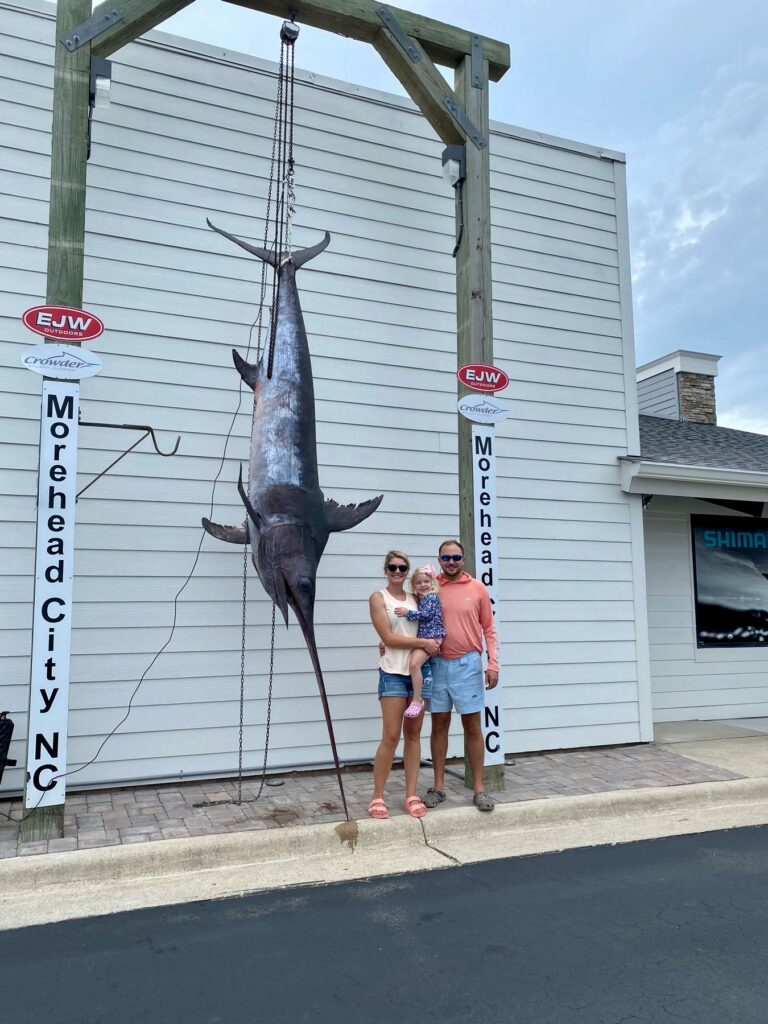
Soft Bites and Tough Fights
While some fish take off on a screaming run instantly, most sword bites are very inconspicuous. Swordfish usually wack a bait three to four times before they commit to eating it. During a drift, the bait gets a natural up-and down motion from the waves and motion of the boat. With the subtle sword bite, sometimes the only way you’ll notice it is when the rod stays loaded as the boat travels back down in a spot where it should be slack.
“Once I get a bite, I crank the bait away from the fish 50’ or so and stop it,” David says. “I’ll keep doing that until the fish eats it, so it looks like the bait’s been injured and is trying to get away to trigger a reaction bite. Then if I get a few more bites without hooking the fish, I’ll drop the weight to the bottom again to simulate that he’s killed the bait. Usually, the fish either eats it on the drop or stays with it, and you can start the process over again.”
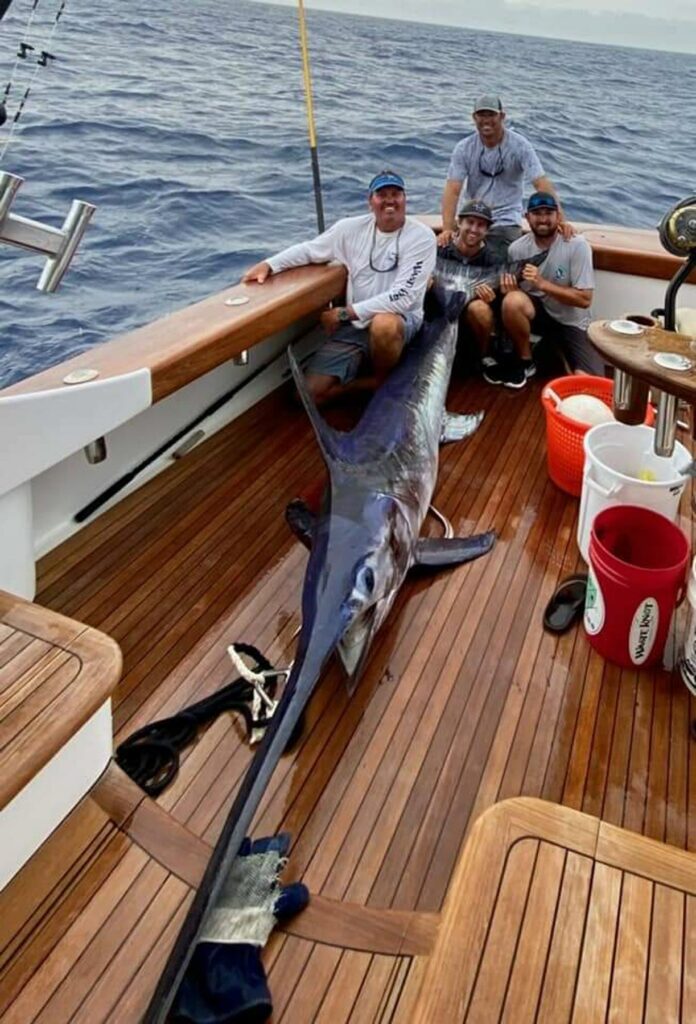
Morris fishes about 20 pounds of drag on the bite, then 15 to 17 pounds on the fight, mostly because of the sword’s soft mouth. He says that generally, larger fish will come towards the surface to get away from the pressure they feel from the weight below them. Often, it’s basically just fighting the weight up as the fish rises in the water column. He says they’re usually angrier when they get to the surface, especially as they cross the thermocline. Take the sinker off when you get it to the rod tip. This is where some people will begin to hand-crank the fish. Swords are notoriously hard fighters, and if you get a chance to see the base of the tail on a big one, you’ll understand why. Most crews use harpoons and gaffs to subdue the fish when it gets close. You’ll need an HMS Angling or HMS Charter/ Headboat permit to take a swordfish recreationally, with a 47” fork length minimum for both permits. Bag limits are one per person, up to four per vessel per trip for recreational and one per paying passenger, and up to six per vessel per trip for a charter boat permit.
Just like any type of fishing, Tickle says that consistency is the key to swordfish success off North Carolina. But if you’re looking for something different to try and the possibility of a new billfish species for your guests, then sword fishing should be on your radar. The “gladiator of the sea” tastes great and fights hard, with year-round availability and low fishing pressure, so you may find that bobbing around in the deep off North Carolina is a worthwhile effort.
Don’t Forget to Check Out Our Sportfishing Job Board! Did You Know? It’s the perfect platform for seeking skilled captains and mates. Whether you’re on the hunt for your dream team or looking to join one, your next big adventure begins here. Explore the opportunities now! Click Here
Dive Deeper into the World of Sportfishing
Unlock Exclusive Savings: Enjoy 50% Off Your Subscription!
Are you ready to explore the thrilling world of sportfishing from the comfort of your home? Subscribe now and embark on a journey filled with captivating stories, expert insights, and insider tips. Choose between our digital or print edition and secure an incredible 50% discount on your subscription.
Subscribe today and get ready for an adventure like no other. Click here to subscribe and elevate your sportfishing experience with InTheBite Sportfishing Magazine.






